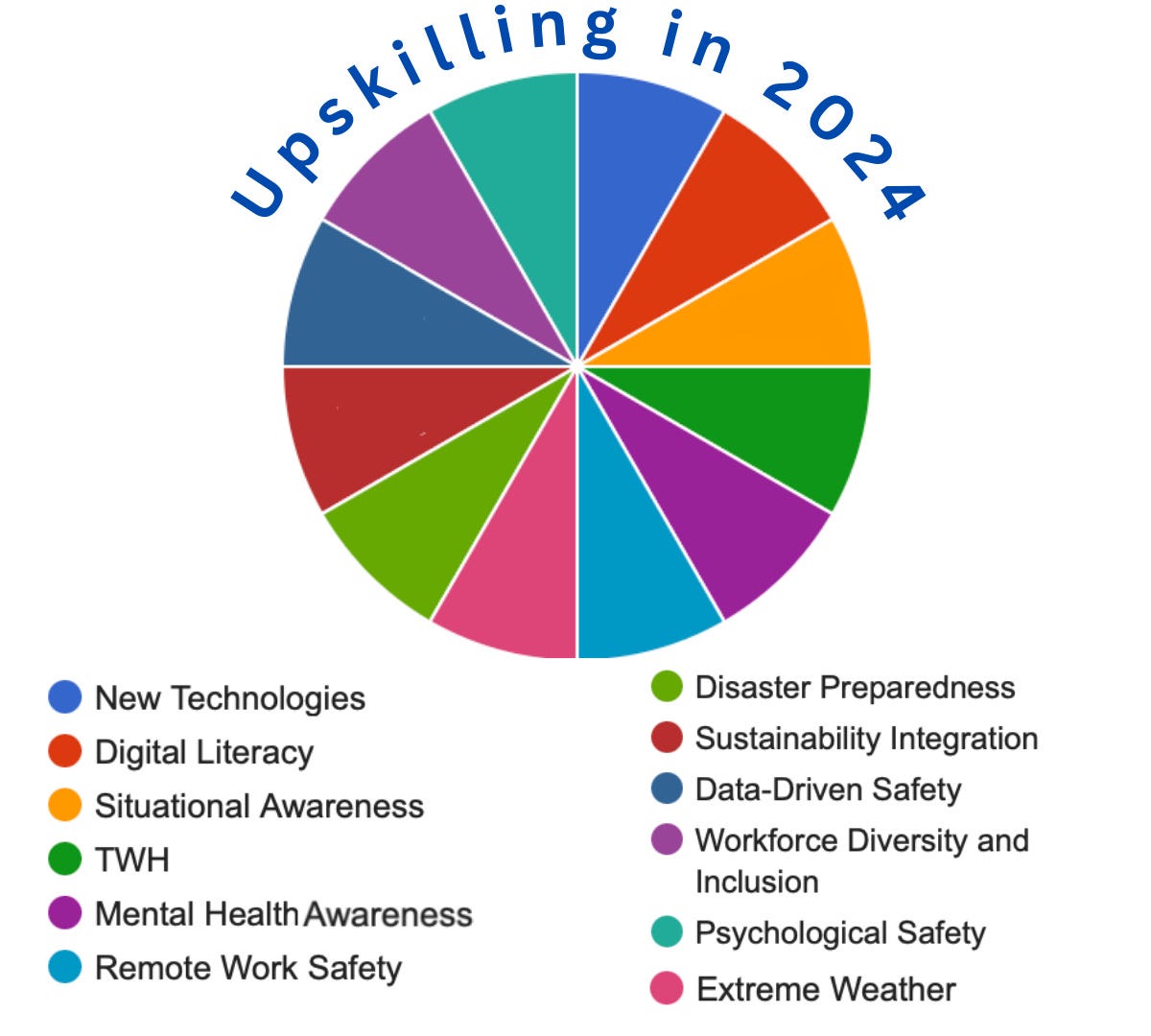Safety Training Net -Dec '24 🔎🎄🌪️✍🏽
Holiday Hazard Hunt, Extreme Weather, Upskilling Collection 2024, Safety Writers Accountability Group, Learning Opportunities
Upskilling
If you read the December 2023 VIP issue, you will be familiar with Upskilling in 2024. This chart includes suggested areas for professional development and each month, I include content on one of the topics as it relates to safety training. This month, we are upskilling in the area of Extreme Weather.
Extreme weather events, such as hurricanes, tornadoes, forest fires, earthquakes, heat waves, and blizzards, present significant challenges to workplace safety and health. Natural disasters not only disrupt business operations but also endanger employees, equipment, and facilities. Being proactive and prepared is crucial for minimizing risks and ensuring worker well-being during these events. Safety trainers can help organizations and individuals to be prepared.
Extreme weather poses three primary categories of risks:
Physical Hazards: These hazards involve direct threats to the physical safety of workers. For example, hurricanes and tornadoes can cause structural damage, falling debris, and flooding, increasing risks of injury. Earthquakes may collapse buildings and create hazardous conditions like gas leaks and fires. Blizzards can lead to icy surfaces, increasing the likelihood of slips, trips, and falls.
Health Risks: Extreme weather can lead to various health issues for workers. Heat waves can cause dehydration, heat exhaustion, or heat stroke, especially for those working outdoors. Forest fires introduce poor air quality and respiratory issues due to smoke inhalation. Prolonged cold exposure during blizzards can lead to frostbite or hypothermia.
Mental and Emotional Hazards: The stress and trauma associated with extreme weather events can also impact workers' mental and emotional well-being. Witnessing destruction, experiencing loss, and facing uncertainty can lead to anxiety, depression, and post-traumatic stress disorder.
Real-World Examples
Several historical events illustrate the devastating impact of extreme weather on workplaces:
Hurricane Katrina (2005): This hurricane devastated the Gulf Coast, destroying infrastructure and workplaces. Many employees in essential services, including healthcare and emergency response, faced hazardous conditions, including exposure to floodwaters contaminated with sewage and chemicals. This disaster highlighted the importance of robust evacuation plans and training for high-risk industries.
Joplin, Missouri Tornado (2011): This EF-5 tornado leveled much of Joplin, including businesses like the local hospital. Employees in retail and manufacturing faced building collapses and injuries from flying debris. Companies with tornado shelters and practiced emergency drills reported fewer injuries and fatalities among employees.
Camp Fire, California (2018): This fire destroyed the town of Paradise, California, including many workplaces. Workers faced evacuation challenges, smoke inhalation, and loss of livelihoods. Businesses with clear evacuation plans and air filtration systems were better equipped to protect their employees.
Preparedness is Key
The examples above demonstrate that preparedness is crucial for minimizing risks during extreme weather events. Employers should:
Develop a Comprehensive Emergency Plan: This plan should include evacuation and shelter-in-place protocols tailored to specific weather risks. A designated team should monitor weather updates and communicate timely information to employees. Safety trainers can help facilitate relevant training and drills.
Provide Training and Resources: Workers should be educated on safety practices for various weather conditions. They should have access to emergency supplies like first aid kits, flashlights, water, and protective gear.
Maintain Safe Work Environments: Structures, machinery, and hazardous materials should be inspected and secured. Investing in backup systems for power and communication can help maintain operations during outages.
Promote Health & Wellbeing: Offering resources for physical and mental health support, including counseling and stress management programs, can help employees cope with the aftermath of extreme weather events. Employers should also encourage hydration and regular breaks during extreme heat or cold.
VIP Subscribers have access to a new related training activity, Extreme Weather: Don’t Take Your Chances, which educates trainees about different types of extreme weather as well as precautions, and follow-up actions for each type of weather emergency (download link in the VIP section). I created an accompanying YouTube video that can be used with the activity which is available to all on the SafetyFUNdamentals YouTube channel.
Kick Start Your 2025 Learning
I talk a lot about upskilling in this newsletter, and that’s because I am a firm believer in Marshall Goldsmith’s words, “What got you here won’t get you there.” Everyone - regardless of their job title or years of experience, needs to strive to improve continuously.
Thanks to the wealth of free online information, there is always somewhere easy to start in any professional development journey. Once you are diving deeper, it may be worth investing in paid resources. The options below offer a mix of providers that can help you to learn just about anything.
Coursera: Offers various courses from universities and companies worldwide.
Khan Academy: Provides free educational resources covering subjects from math to science and more.
edX: Features courses from top universities and institutions across various disciplines.
Udacity: Focuses on vocational courses for professionals, particularly in tech fields.
MIT OpenCourseWare: Offers free lecture notes, exams, and videos from MIT courses.
IBM SkillsBuild: Provides free digital training in STEM, IT, and other sciences.
For subscribers who are also members of the American Society of Safety Professionals, there are a number of free learning opportunities available on the ASSP website. Even if you are not an ASSP member, there are also some resources available to you.
What are you looking forward to learning next year?
Holiday Cooking and Food Prep Hazard Hunt
The holiday season is synonymous with festive meals and family gatherings. However, improper food handling can lead to foodborne illnesses. To help ensure your family and workplace celebrations remain safe, consider sharing the following with anyone involved with food preparations.
Safe Grocery Shopping: When shopping, pick up perishable items like turkey and dairy products at the end of your trip to keep them cold longer. Ensure that meat and poultry packaging is intact and free from leaks to prevent cross-contamination.
Proper Food Storage: Store perishable foods in the refrigerator within two hours of purchase or preparation to inhibit bacterial growth. Instead of aluminum foil, use airtight containers to store leftovers, minimizing exposure to oxygen and reducing bacterial growth.
Thawing and Cooking: Thaw frozen meats in the refrigerator, and avoid thawing at room temperature to prevent bacterial proliferation. When cooking, use a food thermometer to ensure meats reach a safe internal temperature of—165°F for poultry.
Serving and Leftovers: Mind the Two-Hour Rule: - Do not leave perishable foods out for more than two hours. Beyond this, bacteria can multiply to unsafe levels. Reheat leftovers to an internal temperature of 165°F.
I created the above Cooking and Food Prep Hazard Hunt you can use to start these discussions at work, and with home cooks. You can download it, and answer key, here.
Finally, here is a great illustration about food safety from NPR.
Last month, I mentioned my latest book project, The Wiley Guide to Strategies, Ideas, and Applications for Implementing a Total Worker Health Program, and I finally received my copies. It’s amazing to see 2+ years of work compressed into 465 pages. You can see my excitement here.
If you are interested in Total Worker Health or want to learn more, I think you’ll agree that it’s a great new resource for the safety and health community.
Introducing….
I believe all Safety and Health professionals should be published. We each have so much good information to share, and it doesn’t do anyone any good if it only stays in ONE head! Adding “author” to your resume has many benefits. I love helping others to get published, which is why I wanted to try the role of Editor with the TWH book project shown above.
Why am I telling you all this? Because I’d love to help you get published, too! Starting in January, I am kicking off a Safety Writers Accountability Group (SWAG), and you are invited to join. If you are interested, let me know by adding your name and email here, and I will send you the details. For this first cohort, I am limiting the group size to 10, and spots will be allotted based on the order of sign-up. If you have ever thought of writing an article, an eBook, a book chapter, or even a complete book, this group is for you!
In case you missed it, last month I announced a new newsletter created by the authors of the TWH book mentioned above. If you are interested in learning more, click here or scan the code below.
Worker Health and Wellbeing Newsletter
What’s In Your Bag ?
It’s the end of 2024 and the end of the What’s In Your Bag feature. Thank you so much to subscribers Skipper Kendrick, Chris Garza, Pat Karol, Stacey Brooks, Joann Robertson, Joey Shibata, Dan Hopwood, and Sarah Bogner for sharing what you carry so that you are always prepared when delivering training and presentations. You’ve given thousands of subscribers great ideas and resources! Thank you from all of us!
Starting in January, there will be a new twist to What’s In Your Bag and this section will now showcase the favorite training activities of subscribers. Do you have one to share? Simply reply to this email or comment below. Thanks!
PS - to bribe you to share your favorite activity and be featured in a future newsletter, I will give you (or someone you name) a free month of VIP membership in exchange for your participation :)
What’s Up in January?
Yes - it’s almost the start of a New Year! VIP Subscribers will receive the Safety Training Calendar for 2025 separately, which will highlight important events in health and safety that are celebrated and recognized each month in addition to a related activity. If you are not a paid subscriber, consider upgrading today to get this and all VIP content that has been shared since 2021!
UpSkilling Year in Review - for VIPs
2024 was the first year I added monthly upskilling topics to this newsletter. We covered a lot of topics - everything from AI to Weather. I have put all of the upskilling information found in the 12 newsletter issues in one document, along with review questions. Hopefully, this will help you access this new information more easily and will provide you with a way to test how much you remember. If you weren’t a VIP subscriber at the beginning of 2024, remember you have access to all issues and content since the newsletter was started in 2021. The download link can be found in the VIP section below.















